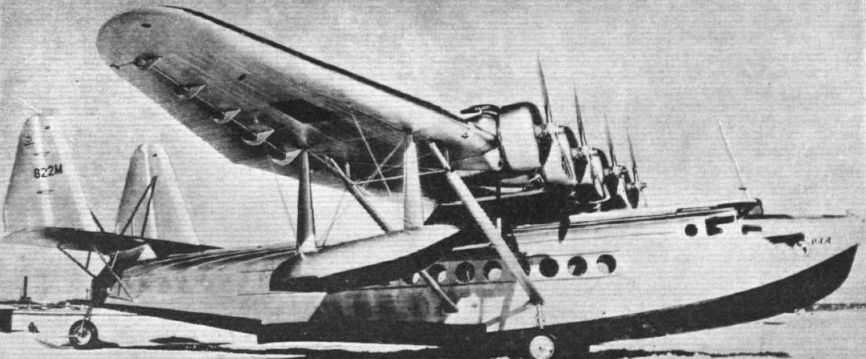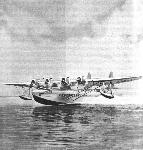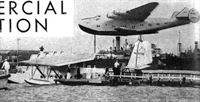
Описание
Страна : США
Год : 1934
Летающая лодка
40-местная летающая лодка большой дальности
Sikorsky S-42
Вскоре "Pan American" стала изучать возможность приобретения еще более крупной и скоростной летающей лодки. 15 августа 1931 года компания подготовила техническое задание на трансатлантическую летающую лодку большой дальности, требовавшее от новой машины возможность перевозить экипаж из четырех человек и 12 пассажиров на расстояние 4023 км с крейсерской скоростью 233 км/ч. 30 ноября 1932 года авиакомпания подписала контракты с "Martin" на осуществление проектирования самолета M-130 и с "Sikorsky" на разработку в рамках "второго этапа" самолета S-42, который имел традиционный корпус летающей лодки (корпус был выполнен двухреданным), двухкилевое хвостовое оперение и оснащался четырьмя двигателями Hornet S5D1G мощностью по 700 л.с., установленными на передней кромке крыла типа парасоль, имевшего очень большое относительное удлинение. Крыло оснащалось закрылками с гидравлическим приводом.
Первый прототип S-42 был построен в 1933 году и совершил первый полет 29 марта 1934 года. Во время испытаний 1 августа 1934 года самолет установил 10 мировых рекордов в своем классе по грузоподъемности и скорости. Испытания проходили на Карибах, включая полет по замкнутому маршруту из Флориды на Виргинские острова и обратно протяженностью 4184 км. 16 апреля 1935 года Эд Мьюзик, старший летчик "Pan Am", совершил на S-42 перелет из Аламеды в Гонолулу, потратив 18 часов 9 минут.
Первый регулярный полет состоялся 16 августа по маршруту Майами - Рио-де-Жанейро. S-42 не смог побить M-130 в дальности полета, но зато эксплуатировался в большем количестве. Всего построили 10 самолетов, включая три S-42, три S-42A с двигателями Hornet S1 EG мощностью по 750 л. с., крылом увеличенного размаха и увеличенной на 907 кг взлетной массой, а также четыре S-42B, которые имели улучшенную аэродинамику и воздушные винты Hamilton Standard постоянного числа оборотов и увеличенную максимальную взлетную массу (на 907 кг), а также более вместительные топливные баки для обеспечения планировавшихся полетов через Атлантический и Тихий океан.
Гигантские летающие лодки позволили "Pan American" открыть трансокеанские маршруты и совершать полеты по направлениям: Нью-Йорк - Бермуды, Майами - Южная Америка, Сиэтл - Аляска и Манила - Гонконг. Самолеты с полезной нагрузкой 363 кг могли преодолевать расстояние 4828 км, либо же с полной нагрузкой - 1931 км. В 1935 году S-42 первыми стали совершать полеты через Тихий океан, с западного побережья США в Манилу или на Филиппины, а в 1937 году самолеты S-42 и S-42B совершали дальние исследовательские перелеты в южной части Тихого океана, Северной Атлантике и из Сан-Франциско в Новую Зеландию через Гонолулу.
ТАКТИКО-ТЕХНИЧЕСКИЕ ХАРАКТЕРИСТИКИ
Sikorsky S-40A
Тип: 40-местная летающая лодка большой дальности
Силовая установка: четыре звездообразных ПД Pratt & Whitney Hornet мощностью по 800 л. с. (596 кВт)
Характеристики: крейсерская скорость 274 км/ч; дальность 1931 км
Масса: макс. взлетная 17237 кг
Размеры: размах крыла 36,02 м; длина 20,62 м; высота 5,31 м; площадь крыла 123,47 м2
- Описание
Фотографии
-
Мировая Авиация 64
Регистрационный номер: NC822M [6] 16-17 апреля 1935г.: самолет Sikorsky S-42 компании "Pan American Airways System" совершил первый пробный полет из Аламедии, Калифорния, на Гавайские острова. Это перелет являлся частью трансокеанского маршрута из Соединенных Штатов на Филиппины.
-
Мировая Авиация 236
Регистрационный номер: NC822M [6] NC822M - первая летающая лодка Sikorsky S-42, полученная "Pan American" и поступившая 16 августа 1934 года на маршрут Майами - Рио-де-Жанейро. Весной 1935 года модифицированная летающая лодка S-42, имевшая увеличенный запас топлива, совершила исследовательский перелет протяженностью 4828 км из Сан-Франциско в Гонолулу.
-
Flight 1934-03 / Flight
Регистрационный номер: NC822M [6] FOR TRANSATLANTIC SERVICE?: The Sikorsky S.42 four-engined flying boat recently completed for Pan-American Airways. After tests it will be put into service between the United States and South America, and subsequently may be used for transatlantic service.
-
Flight 1934-10 / Flight
Регистрационный номер: NC822M [6] PAN-AMERICAN AIRWAYS' LATEST: The Sikorsky S-42, which ts now replacing the older machines on Pan-American Airways' routes, cruises at 160 m.ph with thirty-two passengers and a crew of four.
-
Air Enthusiast 1998-05 / E.Davies - Pioneering the Pacific
Регистрационный номер: NR823M [9] NR823M on its beaching gear at Alameda, circa 1935.
-
Flight 1935-09 / Flight
TRANSOCEANIC CONTRAST. This photograph, recently received from Para, Brazil, shows a B.A. Eagle in company with the famous Sikorsky S.42 Brazilian Clipper. The Eagle is that in which Senor Pombo, who is one of the group, flew the South Atlantic in 16 hr. 40 min. from Bathurst. The picture is of particular interest in view of the fact that the British Aircraft Manufacturing Company hold the rights of building the S.42 in England.
Другие самолёты на фотографии: British Klemm BK-1 Eagle - Великобритания - 1934
-
Flight 1935-06 / Flight
The S.42 at Miami. The rails on which this platform is raised can be seen; a few moments later the platform was level with the quay and the S.42 was pulled off into the hangar by a small motor tractor.
-
Air Enthusiast 1998-05 / E.Davies - Pioneering the Pacific
Регистрационный номер: NR823M [9] ‘PanAmerican Clipper’ preparing to depart Alameda on the inaugural flight to Honolulu.
-
Aeroplane Monthly 1989-11 / Personal album. Civil
Регистрационный номер: NC16734 [2] In 1942 Pan Am issued a specification for a flying-boat to replace its fleet of three Sikorsky S-40s. Two years later, on March 30, 1934 the first S-42 made its first flight after making a brief hop the previous day. Pan Am was now reaching out into the Pacific and new route surveys were in order. One of the new S-42s was modified and outfitted for the Pacific surveys. One year later the modified S-42 was on its way to Alameda on a ferry from Bridgeport, Connecticut, via Acapulco, Mexico with a stop at San Pedro, California, when these photographs were taken on March 30, 1935. The captain of the flight was Edwin C. Musick, a Pan Am veteran who, on January 11, 1938 was in command of Pan Am’s S-42B Samoan Clipper NC16734 which disappeared on a survey flight of the South Pacific area flying out of Pango Pango with a crew of six. Not even an oil slick was found.
-
Jane's All the World Aircraft 1938 / 03 - All the world's aeroplanes
Регистрационный номер: NC16736 [4] The Sikorsky S-42-B Commercial Flying-boat (four 750 h.p. Pratt & Whitney "Hornet" engine).
-
Jane's All the World Aircraft 1938 / 01 - The progress of the world in civil aviation during the year 1937-38
Регистрационный номер: NC16735 The Sikorsky "Clipper," of Pan American Airways, at Bermuda, British terminus of the New York-Bermuda service, in which Imperial Airways participate.
-
Flight 1934-08 / Flight
Регистрационный номер: NC822M [6] BRAZILIAN CLIPPER TAKES OFF: Pan-American Airways' first Sikorsky S-42 leaves Biscayne Bay for Buenos Ayres. It is reported that Short Bros, are building a large trans-oceanic boat for Imperial Airways.
-
Flight 1937-07 / Flight
Регистрационный номер: NC16736 [4] A photograph of the Sikorsky S.42B taken at Southampton after the crossing
-
Aeroplane Monthly 1989-11 / Personal album. Civil
Регистрационный номер: NR823M [9] The picture shows the S-42 NR823M taking off from Los Angeles Harbor with San Pedro in the background.
-
Авиация и Время 2019-04 / А.Хаустов - ... и не только
Самолеты S-42 компании "Pan Am" внесли основополагающий вклад в развитие трансокеанских перелетов. Они обычно совершали полеты в конфигурации на 32 пассажира, хотя использовались варианты и на 40 пассажиров для дневных полетов и на 14 пассажиров - для ночных.
An S-42 ‘on the step’. -
Air Enthusiast 1998-05 / E.Davies - Pioneering the Pacific
Регистрационный номер: NR823M [9] S-42 NR823M over the San Francisco waterfront
-
Flight 1935-06 / Flight
The Brazilian Clipper (Sikorsky S.42) off Honolulu during a trans-Pacific flight.
-
Jane's All the World Aircraft 1980 / Encyclopedia of Aviation - 1. Chronology
Sikorsky S-42 (5-6 July 1937).
-
Air International 1988-12 / In print
A Sikorsky S-42 in service with Pan-Am
-
Flight 1935-11 / Flight
Styles from the States: The Sikorsky S-42 (four 750 h.p. Pratt and Whitney Hornets). The gross weight is 40,000 lb. and maximum speed is 190 m.p.h.
-
Air International 1987-03 / R.Braybrook - The Sixties, the Thirties and the American Challenge
Регистрационный номер: NC822M [6] In the five years leading up to World War II, the US manufacturers produced a series of flying boats for long-distance commercial operation, demonstrating a substantial lead over the rest of the world. They included the Boeing 314, the Sikorsky S-42 (shown) and Martin's M-130 "China Clipper" which, in 1934, entered service to operate a transpacific airmail service.
-
Jane's All the World Aircraft 1938 / 01 - The progress of the world in civil aviation during the year 1937-38
AT BUENOS AIRES. - A Pan American "Clipper" off the Company's base at the New Port. On the point is the base of the Sindicato Condor, and the floating dock out in the basin. This is said to be the first in the World designed specially for Civil aeroplanes, and was built by the local branch of a German company. The R.A.F. have run a whole flying-boat squadron at Pembroke without sheds six or seven years, thanks to a floating dock which was built during the War 1914-18.
-
Jane's All the World Aircraft 1938 / 01 - The progress of the world in civil aviation during the year 1937-38
THE CHEAPEST SORT OF SEAPLANE BASE. - The floating dock of the Sindicato Condor at Buenos Aires. In the upper picture an incoming Pan American Sicorsky S42 gives an idea of the size, and below it is seen occupied by one of the Condeor Junkers Ju52 seaplanes.
Другие самолёты на фотографии: Junkers Ju.52/3mW (See) - Германия - 1933
-
Air Enthusiast 1998-05 / E.Davies - Pioneering the Pacific
Регистрационный номер: NC16734 [2] Гидропланы S-42 и S.23 в порту Окленда. 1937 г.
S-42-B NC16734 and Imperial Airways C-Class ‘Centaurus’ at Auckland, December 1937.Другие самолёты на фотографии: Short Empire / S.23 - Великобритания - 1936
-
Aeroplane Monthly 1989-11 / Personal album. Civil
The picture shows the S-42 arriving at San Pedro, California on March 30,1935.
-
Air Enthusiast 1998-05 / E.Davies - Pioneering the Pacific
Регистрационный номер: NR823M [9] S-42 NR823M at San Pedro, California, March 1935 during the ferry flight from Miami to Alameda.
-
Air Enthusiast 1998-05 / E.Davies - Pioneering the Pacific
Регистрационный номер: NC16736 [4] NC16736 at Ward Cove, Ketchikan in June 1940.
-
Jane's All the World Aircraft 1938 / 01 - The progress of the world in civil aviation during the year 1937-38
THE SOUTHERNMOST JUNCTION. - The "Centaurus" of Imperial Airways (Capt. Burgess) and the "Samoan Clipper" of Pan American Airways (Capt. Mustek) in Waitimata Harbour, Auckland, New Zealand, in January, 1938. The latter was lost with all hands near Pago Pago soon after this meeting.
Другие самолёты на фотографии: Short Empire / S.23 - Великобритания - 1936
-
Flight 1937-12 / Flight
BALTIMORE INAUGURATION: Some of the crowd of 30,000 lining the banks of the Patapsco river to watch the recent inauguration of the new Baltimore Airport for landplanes and marine aircraft. It replaces New York as the terminus of the Bermuda route; the Sikorsky S.42b Bermuda Clipper is seen being brought to the landing stage, and in the background is the Short Empire boat Cavalier.
Другие самолёты на фотографии: Short Empire / S.23 - Великобритания - 1936
-
Jane's All the World Aircraft 1938 / 01 - The progress of the world in civil aviation during the year 1937-38
BALTIMORE SEAPLANE STATION. - The populace turns out to see the "Cavalier," an Empire Boat of Imperial Airways, from Bermuda and a Sikorski "Clipper" of Pan American Airways. Baltimore is the American terminus during the Winter of the Bermuda-U.S.A. airline. In the Summer Port Washington, Long Island, New York, is used.
Другие самолёты на фотографии: Short Empire / S.23 - Великобритания - 1936
-
Flight 1937-12 / Flight
Другие самолёты на фотографии: Short Empire / S.23 - Великобритания - 1936
-
Flight 1937-07 / Flight
The Sikorsky is seen from under the wing of an Empire flying boat, Courtier.
Другие самолёты на фотографии: Short Empire / S.23 - Великобритания - 1936
-
Flight 1939-04 / Flight
Регистрационный номер: NC16736 [4] READY FOR THE CROSSING: The Boeing 314 Yankee Clipper cutting things fine while making an approach at Baltimore after flying over from San Francisco. The machine at the landing stage is the Sikorsky S.42B Bermuda Clipper, which is now being assisted on the Bermuda service by the second of the 314s, Allanite Clipper. At the time of going to press Yankee Clipper was at Biscarosse.
Другие самолёты на фотографии: Boeing Boeing 314 Clipper - США - 1938
-
Flight 1938-01 / Flight
Two of the boats which made history last year - Caledonia and Clipper III - being hauled on to the slipway at Hythe (left). The former was commanded by Capt. Wilcockson and the latter by Capt. Gray on all the Atlantic trips.
-
Flight 1937-07 / Flight Advertisements
The Pan American Airways flying-boat Clipper III, like all the other mainliners in the fleet of this great undertaking, is equipped with airscrews of similar type, manufactured in the United States by The Hamilton Standard Propeller Co.
-
Air Enthusiast 1998-05 / E.Davies - Pioneering the Pacific
Регистрационный номер: NR823M [9] Crowds watching work in progress on the ‘PanAmerican Clipper’ during turnaround, Hawaii, 1935.
-
Air Enthusiast 1998-05 / E.Davies - Pioneering the Pacific
Регистрационный номер: NR823M [9] NR823M again being servicing, this time at Wake Island, October 12, 1935.
-
Air Enthusiast 1998-05 / E.Davies - Pioneering the Pacific
Регистрационный номер: NR823M [9] NR823M upon arrival at Honolulu.
-
Aeroplane Monthly 1989-11 / Personal album. Civil
Capt Musick steps into the cockpit of the S-42 shortly before casting off for the flight to Alameda.
-
Aeroplane Monthly 1989-11 / Personal album. Civil
Los Angeles mayor Frank Shaw reading a proclamation to the 'boat's crew. In addition to Capt Musick the crew included Fred J. Noonan as navigation officer. He disappeared in the Pacific with Amelia Earhart during her attempted round-the-world flight in a Lockheed Electra in 1937.
-
Flight 1937-07 / Flight
ATLANTIC AIDS: The control cabin of Clipper III. In the centre can be seen the Sperry panel, automatic pilot controls and r.p.m. indicators, while on either side are identical panels mounting the essential flying instruments. Below the centre panel can be seen the new Sperry Gyro-Mag compass and the engine controls are mounted in the roof. Across the centre is the rubber band for aileron parking.
-
Air Enthusiast 1998-05 / E.Davies - Pioneering the Pacific
Регистрационный номер: NR823M [9] THE THIRD PILOT: The control room of Pan-American Airways' special long distance Sikorsky S.42. which is now at San Diego California, preparatory to making its first experimental trip across the Pacific. During the recent 2,504-mile test flight from Miami to the Virgin Islands and back, the Sperry Gyropilot was in control for two-thirds of the time, while Capt. E. C. Musick (left) and First Officer R. O. D. Sullivan attended to the navigation and to the experimental equipment.
Captains Musick (left) and Sullivan at the controls of NR823M, 1935. -
Flight 1937-10 / Flight
The Sikorsky S.42. A slightly modified version has been used for transatlantic experiments.
-
Flight 1937-07 / Flight
"Clipper III"
- Фотографии















































